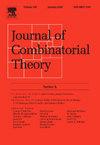满足Griesmer界或具有最优最小距离的二进制自正交码
IF 1.2
2区 数学
Q2 MATHEMATICS
引用次数: 0
摘要
本文的目的是双重的。首先,我们利用solomon - stiff码刻画了满足Griesmer界的二进制自正交码的存在性。因此,我们将一个有无限种情况的问题简化为有限种情况。其次,通过考虑二进制自正交码的残差码,给出了证明某些二进制自正交码不存在的一般方法。利用这样的表征,我们完全确定了dso(n,7)的精确值,其中dso(n,k)表示所有二进制自正交[n,k]码之间的最大最小距离。本文章由计算机程序翻译,如有差异,请以英文原文为准。
Binary self-orthogonal codes which meet the Griesmer bound or have optimal minimum distances
The purpose of this paper is two-fold. First, we characterize the existence of binary self-orthogonal codes meeting the Griesmer bound by employing the Solomon-Stiffler codes. As a result, we reduce a problem with an infinite number of cases to a finite number of cases. Second, we develop a general method to prove the nonexistence of some binary self-orthogonal codes by considering the residual code of a binary self-orthogonal code. Using such a characterization, we completely determine the exact value of , where denotes the largest minimum distance among all binary self-orthogonal codes.
求助全文
通过发布文献求助,成功后即可免费获取论文全文。
去求助
来源期刊
CiteScore
2.90
自引率
9.10%
发文量
94
审稿时长
12 months
期刊介绍:
The Journal of Combinatorial Theory publishes original mathematical research concerned with theoretical and physical aspects of the study of finite and discrete structures in all branches of science. Series A is concerned primarily with structures, designs, and applications of combinatorics and is a valuable tool for mathematicians and computer scientists.

 求助内容:
求助内容: 应助结果提醒方式:
应助结果提醒方式:


